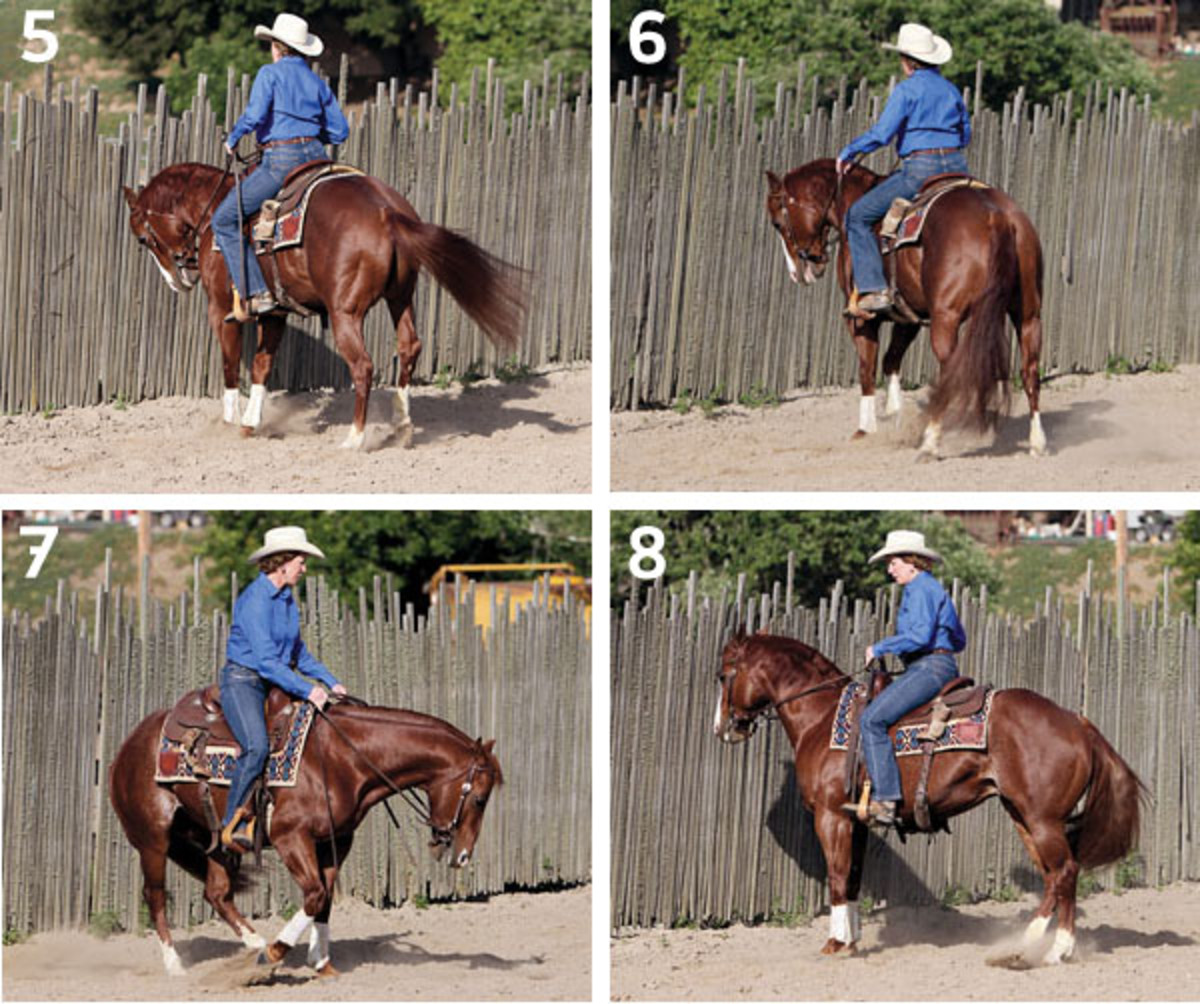This exercise is all about making the spin the easy part that my horse hunts for. I start with the turn, and then, if he doesn’t complete the spin to my expectations, I make the horse work by sidepassing to the same direction while facing the fence. The combination of the 1¼ turn and the sidepass requires your horse to move off your leg, and the fence’s presence eliminates the guesswork—you can feel your horse move off your leg to the side, which should help him move off your leg in the turn, too.
Once my horse is solid with 1¼ turns, I’ll add another revolution. It’s especially beneficial for a horse that hangs up or stalls out after a couple turns. The turn becomes the easy part that he seeks, because the lateral movement is a lot more work.
Here, I’m demonstrating the exercise in a snaffle bit and riding with two hands. You can do the drill in any bit your horse finds comfortable, but I do advise always riding with two hands for this tune-up. As you can see, my fence is a solid wall; however, you can complete this exercise alongside a regular arena fence.
1. I begin by walking parallel to the fence. I make sure my horse’s face is soft and giving at the poll, and I use my right hand to tip his nose toward the fence, as I am here—I always want him to follow his nose into a turn. My left hand is in neutral, and will follow through with support as we progress through the turn. My left leg puts pressure on my horse to move his front end to the right.

2. We continue through the turn—you can really see here that my right leg is off and out of the way to “open a door” for my horse to turn through. Here, he’s crossing his left leg in front of his right, which is good form for a turn.
3. And here’s the problem spot: He’s started to lag through his turn, leaving his left shoulder behind. He’s lost his momentum and is getting a bit lazy as he finishes his turn.
4. Now’s when the work starts. We finish the 450-degree turn facing the fence. I gather up my reins, ask him to give at the poll, and prepare to move him laterally. It’s a lot of work for him to yield sideways to my leg, without the option of forward motion, thanks to the fence.
5. I soften his face with my hands and use my left leg to cue him to move his front and hind ends to the right. It’s important that he yield on both ends for three to four steps to the right. If he gets stuck moving both ends together, I move the hind and then the front, so I’m still traveling down the fence, perpendicular to it.

6. Once he’s softened and moved laterally (the hard-work part), I release the pressure on his face and side, and then I quietly ask him to move his front end over to the right 90 degrees so we can walk down parallel to the fence, but going the opposite way this time (my left leg is now next to the fence). We both relax and walk for several steps before I ask him to turn again (the less-work part), this time to the left. I tip his nose to the left and then follow through with pressure from my right leg, leaving my left leg off of him, so he has a place to go. My right rein is in a supporting position, but never crosses his neck.
7. I keep the pressure on his right side to continue through the spin, using my left rein to guide his nose. It looks like he’s losing momentum again and getting lazy. So I’ll mentally prepare to set him up for lateral movement to the left when we’re facing the fence again.
8. Just like when we moved laterally to the right, I’ll gather his face to ask him to flex at the poll and use pressure from my right leg to move my horse’s front and hind ends to the left, with the fence blocking any forward movement. I’ll keep up with the lateral movement until I feel him respond to the pressure from my leg, then I’ll turn 90 degrees to the left, so he’s parallel to the fence, and walk alongside it with my right leg next to the fence. With a few repetitions, my horse will better respond to leg pressure in his turns, making for a quicker, more fluid movement.
Sandy Collier, Buellton, California, was the first and only woman thus far to win the National Reined Cow Horse Association’s Snaffle Bit Futurity open division. She’s a highly respected trainer and clinician, as well as an inductee into the National Cowgirl Hall of Fame.






